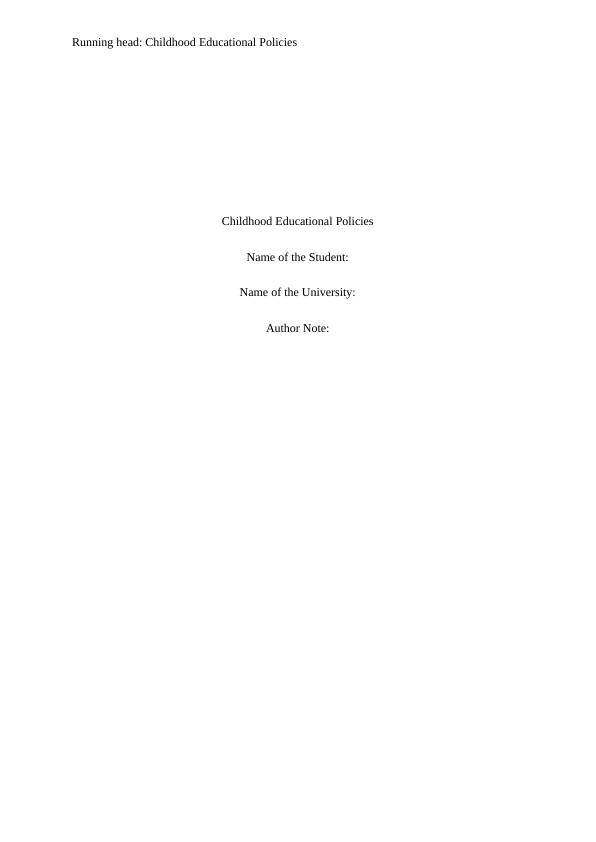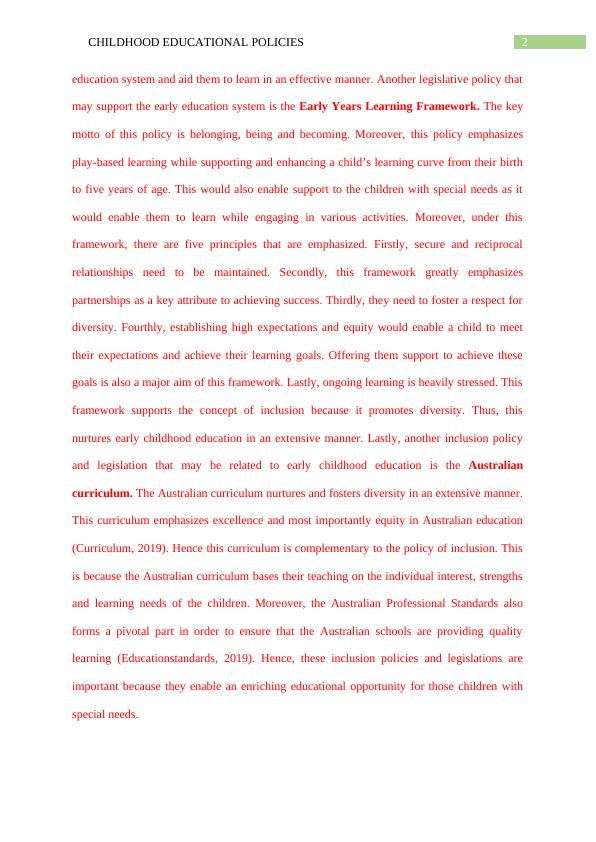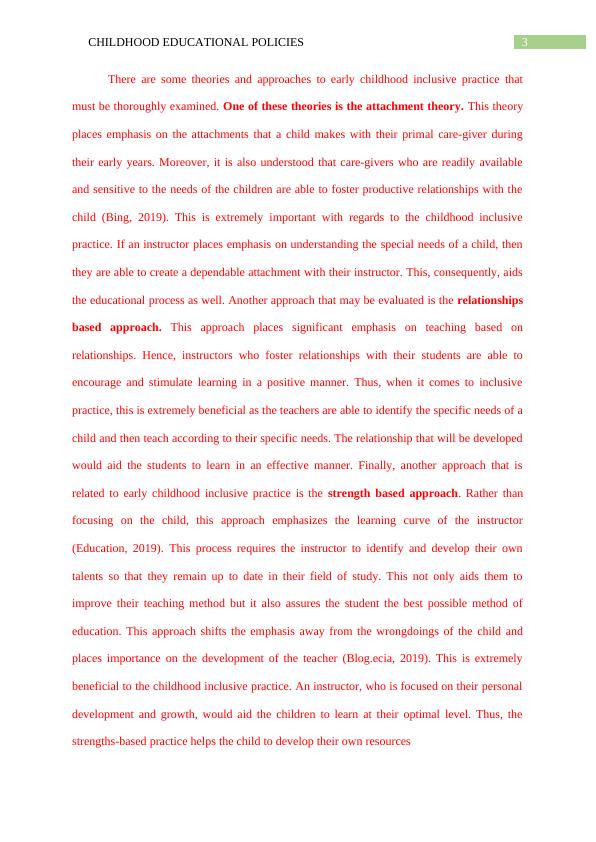Childhood Educational Policies
Added on 2022-10-04
11 Pages2973 Words130 Views
Running head: Childhood Educational Policies
Childhood Educational Policies
Name of the Student:
Name of the University:
Author Note:
Childhood Educational Policies
Name of the Student:
Name of the University:
Author Note:

1CHILDHOOD EDUCATIONAL POLICIES
Early childhood education is a term that may be utilized in order to describe the
various types of educational programs that caters to children during their early educational
years. This particular type of education is comprised of numerous activities and programs that
are specifically designed in order to aid the social and cognitive development of preschoolers
before they commence elementary school. These preschool educational programs are
produced for those children who are three, four or five years old. Moreover, in order to cater
to the requirements of these children, these programs are extremely flexible. For instance,
these educational programs may be conducted at public schools or they may even be home-
based. Even though the concept of pre-school is not something that is compulsory for the
children in Australia, it should be a practice which the government should encourage
(YouTube, 2019). This is because early education lays the foundation for knowledge and thus
children would achieve a head start even before they tread on their official educational
journey. Additionally, early childhood education proves to nurture the holistic development
of a child’s social, cognitive and emotional needs. In fact, in early childhood education,
inclusive schooling must be emphasized upon. The focal point of this discussion is to
minutely analyze and critique the legislation and policies that apply to early childhood
education in Australia. Furthermore, the role of the family and instructors on a child during
their early educational years will also be evaluated.
When it comes to early childhood in Australia, the inclusion policy needs to be
examined. The inclusion policy not only supports children’s rights but it also implements the
current thinking about a child’s development (EarlyChildhoodAustralia, 2019). One of the
policies that support the inclusion policy is the National Disability Insurance Scheme
(NDIS). This is a new legislative framework, imposed by the Australian government in order
to support the Australians with disability, their families and the caregiver. Hence, this is
extremely beneficial with the children with special needs. This would integrate them into the
Early childhood education is a term that may be utilized in order to describe the
various types of educational programs that caters to children during their early educational
years. This particular type of education is comprised of numerous activities and programs that
are specifically designed in order to aid the social and cognitive development of preschoolers
before they commence elementary school. These preschool educational programs are
produced for those children who are three, four or five years old. Moreover, in order to cater
to the requirements of these children, these programs are extremely flexible. For instance,
these educational programs may be conducted at public schools or they may even be home-
based. Even though the concept of pre-school is not something that is compulsory for the
children in Australia, it should be a practice which the government should encourage
(YouTube, 2019). This is because early education lays the foundation for knowledge and thus
children would achieve a head start even before they tread on their official educational
journey. Additionally, early childhood education proves to nurture the holistic development
of a child’s social, cognitive and emotional needs. In fact, in early childhood education,
inclusive schooling must be emphasized upon. The focal point of this discussion is to
minutely analyze and critique the legislation and policies that apply to early childhood
education in Australia. Furthermore, the role of the family and instructors on a child during
their early educational years will also be evaluated.
When it comes to early childhood in Australia, the inclusion policy needs to be
examined. The inclusion policy not only supports children’s rights but it also implements the
current thinking about a child’s development (EarlyChildhoodAustralia, 2019). One of the
policies that support the inclusion policy is the National Disability Insurance Scheme
(NDIS). This is a new legislative framework, imposed by the Australian government in order
to support the Australians with disability, their families and the caregiver. Hence, this is
extremely beneficial with the children with special needs. This would integrate them into the

2CHILDHOOD EDUCATIONAL POLICIES
education system and aid them to learn in an effective manner. Another legislative policy that
may support the early education system is the Early Years Learning Framework. The key
motto of this policy is belonging, being and becoming. Moreover, this policy emphasizes
play-based learning while supporting and enhancing a child’s learning curve from their birth
to five years of age. This would also enable support to the children with special needs as it
would enable them to learn while engaging in various activities. Moreover, under this
framework, there are five principles that are emphasized. Firstly, secure and reciprocal
relationships need to be maintained. Secondly, this framework greatly emphasizes
partnerships as a key attribute to achieving success. Thirdly, they need to foster a respect for
diversity. Fourthly, establishing high expectations and equity would enable a child to meet
their expectations and achieve their learning goals. Offering them support to achieve these
goals is also a major aim of this framework. Lastly, ongoing learning is heavily stressed. This
framework supports the concept of inclusion because it promotes diversity. Thus, this
nurtures early childhood education in an extensive manner. Lastly, another inclusion policy
and legislation that may be related to early childhood education is the Australian
curriculum. The Australian curriculum nurtures and fosters diversity in an extensive manner.
This curriculum emphasizes excellence and most importantly equity in Australian education
(Curriculum, 2019). Hence this curriculum is complementary to the policy of inclusion. This
is because the Australian curriculum bases their teaching on the individual interest, strengths
and learning needs of the children. Moreover, the Australian Professional Standards also
forms a pivotal part in order to ensure that the Australian schools are providing quality
learning (Educationstandards, 2019). Hence, these inclusion policies and legislations are
important because they enable an enriching educational opportunity for those children with
special needs.
education system and aid them to learn in an effective manner. Another legislative policy that
may support the early education system is the Early Years Learning Framework. The key
motto of this policy is belonging, being and becoming. Moreover, this policy emphasizes
play-based learning while supporting and enhancing a child’s learning curve from their birth
to five years of age. This would also enable support to the children with special needs as it
would enable them to learn while engaging in various activities. Moreover, under this
framework, there are five principles that are emphasized. Firstly, secure and reciprocal
relationships need to be maintained. Secondly, this framework greatly emphasizes
partnerships as a key attribute to achieving success. Thirdly, they need to foster a respect for
diversity. Fourthly, establishing high expectations and equity would enable a child to meet
their expectations and achieve their learning goals. Offering them support to achieve these
goals is also a major aim of this framework. Lastly, ongoing learning is heavily stressed. This
framework supports the concept of inclusion because it promotes diversity. Thus, this
nurtures early childhood education in an extensive manner. Lastly, another inclusion policy
and legislation that may be related to early childhood education is the Australian
curriculum. The Australian curriculum nurtures and fosters diversity in an extensive manner.
This curriculum emphasizes excellence and most importantly equity in Australian education
(Curriculum, 2019). Hence this curriculum is complementary to the policy of inclusion. This
is because the Australian curriculum bases their teaching on the individual interest, strengths
and learning needs of the children. Moreover, the Australian Professional Standards also
forms a pivotal part in order to ensure that the Australian schools are providing quality
learning (Educationstandards, 2019). Hence, these inclusion policies and legislations are
important because they enable an enriching educational opportunity for those children with
special needs.

3CHILDHOOD EDUCATIONAL POLICIES
There are some theories and approaches to early childhood inclusive practice that
must be thoroughly examined. One of these theories is the attachment theory. This theory
places emphasis on the attachments that a child makes with their primal care-giver during
their early years. Moreover, it is also understood that care-givers who are readily available
and sensitive to the needs of the children are able to foster productive relationships with the
child (Bing, 2019). This is extremely important with regards to the childhood inclusive
practice. If an instructor places emphasis on understanding the special needs of a child, then
they are able to create a dependable attachment with their instructor. This, consequently, aids
the educational process as well. Another approach that may be evaluated is the relationships
based approach. This approach places significant emphasis on teaching based on
relationships. Hence, instructors who foster relationships with their students are able to
encourage and stimulate learning in a positive manner. Thus, when it comes to inclusive
practice, this is extremely beneficial as the teachers are able to identify the specific needs of a
child and then teach according to their specific needs. The relationship that will be developed
would aid the students to learn in an effective manner. Finally, another approach that is
related to early childhood inclusive practice is the strength based approach. Rather than
focusing on the child, this approach emphasizes the learning curve of the instructor
(Education, 2019). This process requires the instructor to identify and develop their own
talents so that they remain up to date in their field of study. This not only aids them to
improve their teaching method but it also assures the student the best possible method of
education. This approach shifts the emphasis away from the wrongdoings of the child and
places importance on the development of the teacher (Blog.ecia, 2019). This is extremely
beneficial to the childhood inclusive practice. An instructor, who is focused on their personal
development and growth, would aid the children to learn at their optimal level. Thus, the
strengths-based practice helps the child to develop their own resources
There are some theories and approaches to early childhood inclusive practice that
must be thoroughly examined. One of these theories is the attachment theory. This theory
places emphasis on the attachments that a child makes with their primal care-giver during
their early years. Moreover, it is also understood that care-givers who are readily available
and sensitive to the needs of the children are able to foster productive relationships with the
child (Bing, 2019). This is extremely important with regards to the childhood inclusive
practice. If an instructor places emphasis on understanding the special needs of a child, then
they are able to create a dependable attachment with their instructor. This, consequently, aids
the educational process as well. Another approach that may be evaluated is the relationships
based approach. This approach places significant emphasis on teaching based on
relationships. Hence, instructors who foster relationships with their students are able to
encourage and stimulate learning in a positive manner. Thus, when it comes to inclusive
practice, this is extremely beneficial as the teachers are able to identify the specific needs of a
child and then teach according to their specific needs. The relationship that will be developed
would aid the students to learn in an effective manner. Finally, another approach that is
related to early childhood inclusive practice is the strength based approach. Rather than
focusing on the child, this approach emphasizes the learning curve of the instructor
(Education, 2019). This process requires the instructor to identify and develop their own
talents so that they remain up to date in their field of study. This not only aids them to
improve their teaching method but it also assures the student the best possible method of
education. This approach shifts the emphasis away from the wrongdoings of the child and
places importance on the development of the teacher (Blog.ecia, 2019). This is extremely
beneficial to the childhood inclusive practice. An instructor, who is focused on their personal
development and growth, would aid the children to learn at their optimal level. Thus, the
strengths-based practice helps the child to develop their own resources

End of preview
Want to access all the pages? Upload your documents or become a member.
Related Documents
Inclusion in the domain of education Assignment PDFlg...
|22
|5397
|22
Inclusive Education in Early Childhood Settinglg...
|9
|2934
|72
Child Care Facility Under Consideration Case Study 2022lg...
|18
|4951
|34
Framework for Early Childhood Educationlg...
|13
|3564
|110
Inclusive Education in Early Childhood - Essaylg...
|12
|3729
|49
Inclusion in Special Education: Models, Strategies, and Benefitslg...
|15
|3790
|337
